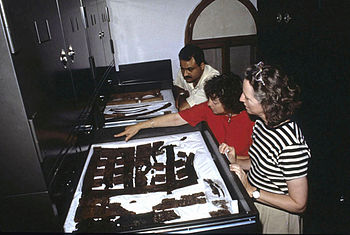Gordion Furniture and Wooden Artifacts
A spectacular collection of furniture and wooden artifacts was excavated by the University of Pennsylvania at the site of Gordion (Latin: Gordium), the capital of the ancient kingdom of Phrygia in the early first millennium BC.
Several pieces of furniture are highly ornate, profusely inlaid with geometric patterns that exhibit sophisticated types of symmetry, and featuring designs that symbolize the Phrygian Mother Goddess Matar (Kybele).
The furniture from the largest tomb at Gordion, Tumulus MM, is associated with King Midas, the powerful Phrygian ruler of the eighth century BC.
The central Anatolian site of Gordion was first excavated by Gustav and Alfred Körte in 1900 and then by Professor Rodney S. Young of the University of Pennsylvania in a major campaign between 1950 and 1973.
[1] Among the many exceptional Phrygian artifacts recovered were more than one hundred wooden objects dating to the eighth century BC—a rare find, since organic materials seldom survive in buried conditions.
The wood discovered by the Körte brothers consisted mainly of furniture fragments from a tumulus burial (K-III), which were significant but too fragmentary to be well understood.
During the production of this volume, many of the early interpretations of the wooden artifacts were found to be incorrect, and a reassessment of the finds was begun by Dr. Elizabeth Simpson, now emeritus professor of ancient art and archaeology at the Bard Graduate Center, New York, NY.
lt was believed that this had been caused by water that seeped into the tomb as a result of drilling in order to determine the location of the chamber prior to excavation.
A project to study and conserve the Gordion wooden artifacts was then organized under her direction with the support of the University of Pennsylvania Museum of Archaeology and Anthropology.
Work has been carried out since that time by the Gordion Furniture Project team in the Museum of Anatolian Civilizations (Anadolu Medeniyetleri Müzesi), Ankara, Turkey.
[6] The exact nature of the furniture was not clear to Young and his team when they entered the chamber in 1957, as many of the objects had broken along the lines of the joinery, with their constituent parts dispersed on the tomb floor.
The four-sided frame was carved as a series of panels, connected by double bars, and inlaid with geometric patterns such as fields of squares or diamonds, configurations of hooks, rosette-like designs, and mazes.
Research has shown that this system of joinery was widespread in antiquity, attested in the Middle Bronze Age tombs of Jericho and in the Pazyryk burials of the fourth century BC.
[11] This surprising play with symmetry indicates that the Phrygian woodworkers were clever, imaginative artisans with a pronounced mathematical orientation.This impression was confirmed by an analysis of the prominent designs at the center of the screen faces, which have now been identified as religious symbols.
[13] The top pieces featured large wooden rings that had held small bronze cauldrons, ten of which were found nearby in the tomb.
The feast included a spicy stew, made with barbecued sheep or goat, honey, wine, olive oil, and most likely lentils, seasoned with anise or fennel.
The small bronze cauldrons that sat in the tops of the serving stands had contained a mixed fermented beverage of grape wine, barley beer, and honey mead.
Tumulus P, excavated in 1956, covered the tomb of a small child, who was buried with bronze vessels, fibulae, and belts; iron implements; painted and monochrome pottery; and a glass bowl—as well as 21 or more pieces of furniture and 49 other wooden objects.
[19] Found near the stand in the southwest corner of the tomb were pieces of a carved wooden stool, inlaid in geometric patterns and studded with bronze tacks.
[20] Not content with this amusing play with form and dimension, the cabinetmakers then negated the force of the metaphor by alternating the colored woods, producing the impression of a series of dark and light stripes.
Close examination has revealed tool marks indicating that the plates were made on an ancient reciprocating lathe—the earliest evidence for the lathe from a securely dated archaeological context.
[22] The destruction level of the city mound yielded carbonized fragments of what may be a serving stand, an inlaid table, and other elaborate pieces of furniture, fitted with bronze studs and brackets as well as finely carved ivory plaques.
The same polymer was utilized in more concentrated form to carry out repairs; for particularly fragmentary objects, glass microspheres were added to the solution to make a paste for filling gaps and reinforcing joins.
Thirty years of study have yielded extensive information about the woods, tools, and techniques used by the royal cabinetmakers, who were surely among the greatest craftsmen of their time.











